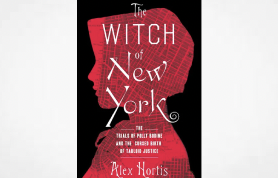ABA Jnl
On a Saturday afternoon in April 1845, Mary “Polly” Bodine, after a three-week trial and more than two days of deliberations, was found guilty of murder by a Manhattan jury.
The gallows awaited.
But Polly was spared the hangman’s noose. Three months later, New York’s highest court (known then as the Supreme Court of Judicature) determined that she had been denied the right to a fair and impartial jury. The court found that extensive pretrial press coverage of the case, painting the accused in a negative light, had tainted those who sat in judgment.
The futility in choosing a panel for her retrial laid bare just how considerable the prejudging had been. After nearly three weeks, and the court’s examination of close to 4,000 prospective jurors, seating twelve unbiased citizens of Gotham remained elusive. The do-over proceeding had to be moved. It landed in Newburgh, New York, a town 60 miles north.
The case of Polly Bodine is the subject of Alex Hortis’ new book, The Witch of New York. But a whodunnit is only part of the story that Hortis, the associate university counsel at the University of Maryland Baltimore, sets out to tell. The book’s subtitle shares the rest: “The cursed birth of tabloid justice.”
Learn more




